Marriage
Aleck the deluded gander
Details from Life magazine (May 18, 1953):
I haven't been able to find any info about what became of Aleck after the Life article made him famous. How long did he live? According to google, geese in captivity can sometimes live for as long as 40 years. So Aleck might have been standing guard by that oil drum for many years.
Posted By: Alex - Wed Jul 05, 2023 -
Comments (0)
Category: Animals, Husbands, Marriage, 1950s
How to quit your job and get married on $25 a week
The 1940s answer, according to the Forum Cafeteria in St. Louis, was to save money by eating at their restaurant. Based on the menu, it sounds like it was decent food.I don't think you'd ever save money by eating out nowadays, unless you're ordering from the dollar menu at a fast food restaurant.

St. Louis Post Dispatch - May 1, 1941
Posted By: Alex - Wed Jun 07, 2023 -
Comments (0)
Category: Restaurants, Advertising, Marriage, 1940s
Hypnosis Test for Divorce
Uncertain about whether to get divorced? Dr. Herbert Mann promised that hypnotism would provide an answer.
Passaic Herald-News - Oct 18, 1965
Posted By: Alex - Wed Mar 08, 2023 -
Comments (2)
Category: Hypnotism, Mesmerism and Mind Control, Divorce, Marriage, 1960s
Teach your wife to be a widow
Donald L. Rogers was financial editor of the New York Herald Tribune. He originally wrote "Teach your wife to be a widow" as an article for Collier's Magazine, and later expanded it into a book (1952).
The article (and book) urged husbands to educate their wives about finances, so that in case the husband died the wife wouldn't end up going destitute.
I think Jean Mayer's article, "How to murder your husband," pairs particularly well with it. Both appeared in the 1981 Reader's Digest collection, Love and Marriage.


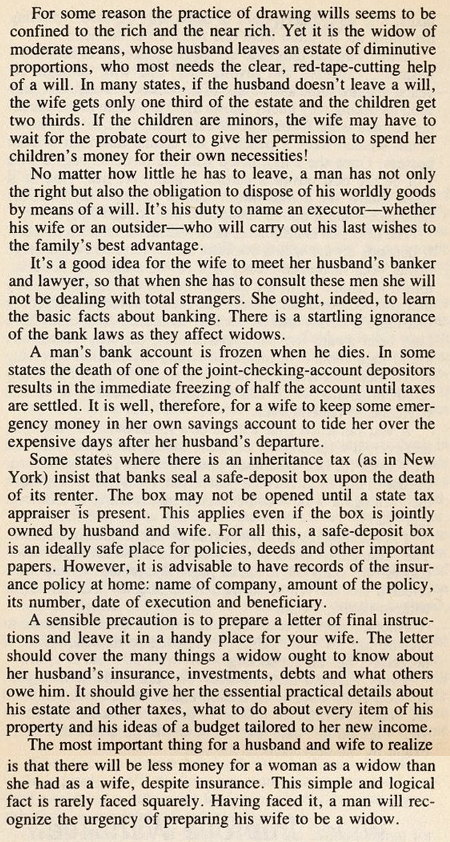



Posted By: Alex - Sun Dec 04, 2022 -
Comments (3)
Category: Money, Husbands, Wives, Books, Marriage
Miss Voodoo
Stella Danfray, aka "Miss Voodoo," seemed poised to become a movie star when she arrived in the United States from France in 1950. She had all kinds of meetings lined up with Hollywood bigwigs.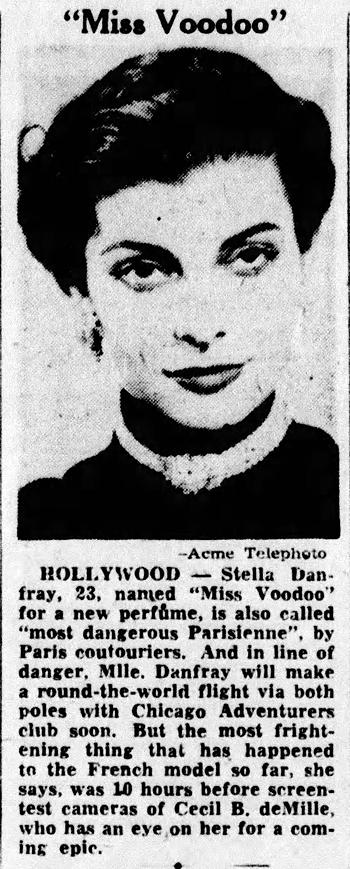
New Castle News - Jan 7, 1950
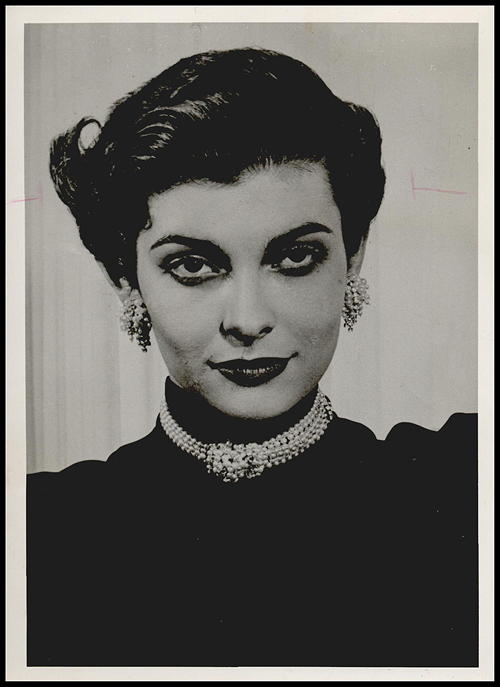
Source: Oklahoma Historical Society
But it turned out that Miss Voodoo had some peculiar views about marital relations. Unprompted, she told a reporter that she thought American husbands were browbeaten and should slap their wives.
I don't know if this comment ended her Hollywood career before it even began (as far as I can tell, she never appeared in any movies), but it definitely turned the American press against her. Within a few months she had left America. She continued working as a model in Europe for a number of years. I don't find any more references to her after 1955.
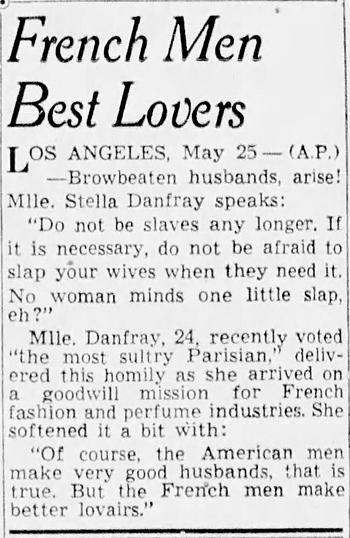
Montreal Daily Star - May 25, 1950
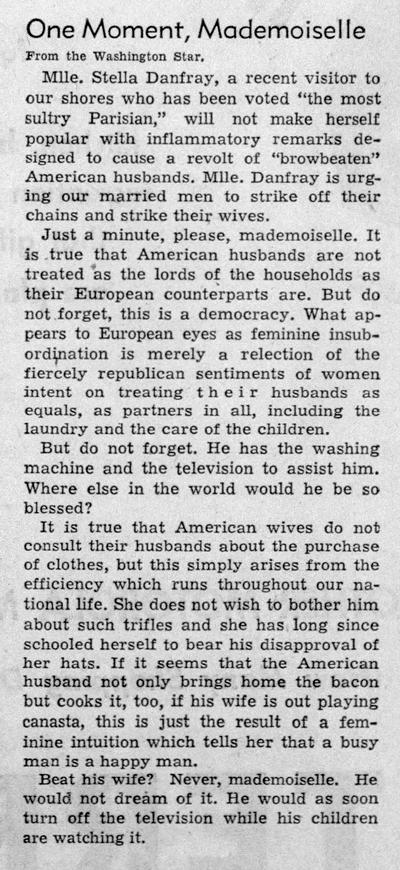
La Crosse Tribune - Sep 24, 1950
Posted By: Alex - Sun Oct 23, 2022 -
Comments (0)
Category: Awards, Prizes, Competitions and Contests, Husbands, Wives, Marriage, 1950s
The marriage of industry and electronics
I like the image, but it seems like it belonged on the cover of a science-fiction magazine, not in an ad for Revere kitchen ware. After all, a woman marrying a robot raises a few intriguing questions.
Saturday Evening Post - Nov 15, 1947
Posted By: Alex - Tue Sep 27, 2022 -
Comments (5)
Category: Advertising, AI, Robots and Other Automatons, Marriage, 1940s
The woman who married a rag doll
Recently in the news: Meirivone Rocha Moraes of Brazil married a rag doll named Marcelo, and now claims that she's had a child with him. The kid is also a rag doll.More info: NY Post


Posted By: Alex - Sat Jun 25, 2022 -
Comments (2)
Category: Marriage, Dolls and Stuffed Animals, Pregnancy
Games Couples Play, #2
July 1947: Newlyweds Jane and Lloyd Gulledge of Dearborn, Michigan decided to play a couple of rounds of Russian roulette. Lloyd lost. "Police say they had been drinking."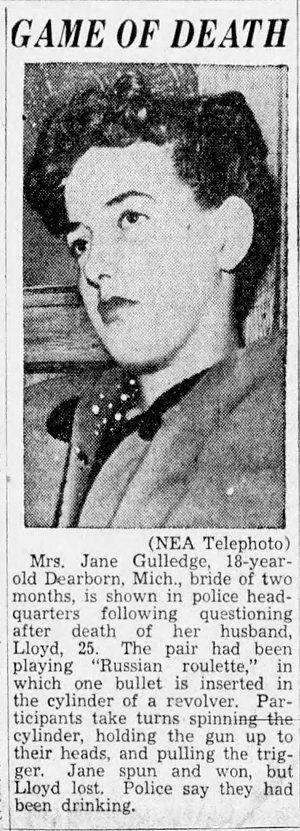
Lancaster Eagle Gazette - Jul 28, 1947

(L) Nevada State Journal - Jul 29, 1947; (R) Palm Beach Post - Aug 3, 1947
Related: Games Couples Play, #1
Posted By: Alex - Thu Jun 09, 2022 -
Comments (3)
Category: Marriage, 1940s, Weapons
Multiple wives for men over 60
April 1966: Noting that there are more women than men over the age of 60, and that women over age 60 often are widowed and may "subsist on inadequate diets and live in a state of sexual frustration," Utah physician Victor Kassel proposed a solution: allow men over age 60 to have more than one wife. In this way, many lonely, older women might once again have a husband, albeit one they're sharing
The Baytown Sun - Apr 19, 1966
In later remarks, Kassel complained that the publicity which his proposal received overemphasized the sexual aspects of his proposal. But to be fair to the media, he himself drew attention to some of the sexual benefits (for men) of polygyny:

left: Idaho Daily Statesman - Sep 11, 1966; right: Fort Lauderdale News - Apr 16, 1966
One English wife offered the following response to Kassel's proposal:

Sunday Mirror - Apr 24, 1966
Some general remarks:
- I don't know why many news articles referred to him as "Victory Kassel". His name was Victor.
- The media frequently said he was promoting polygamy (multiple spouses), when he was actually, more specifically, advocating polygyny (multiple wives).
- One might assume that because Kassel lived in Salt Lake City and was promoting polygyny, that he was Mormon. He was actually Jewish, born in New York City.
- According to his obituary published in The Deseret News (Mar 11, 2005), he later admitted that his proposal was "tongue-in-cheek". I managed to find a reprint of his article and made a pdf copy of it. Parts of it do seem like he was trying to be intentionally outrageous, such as the passage below. But judge for yourself.
It can be argued that the jealousy aroused as the result of the competition would be carried to an extreme by the women and would disrupt the quiet, peaceful home. This may occur. But when there is a choice between uninterested, dowdy, foul-smelling hags and alert, interested, smartly dressed ladies, the selection is obvious.
Posted By: Alex - Mon Apr 18, 2022 -
Comments (3)
Category: Elderly and Seniors, Marriage, 1960s
A Year at Sea
Most unique trial for a marriage ever!Source: The San Francisco Examiner (San Francisco, California) 23 Apr 1972, Sun Page 3

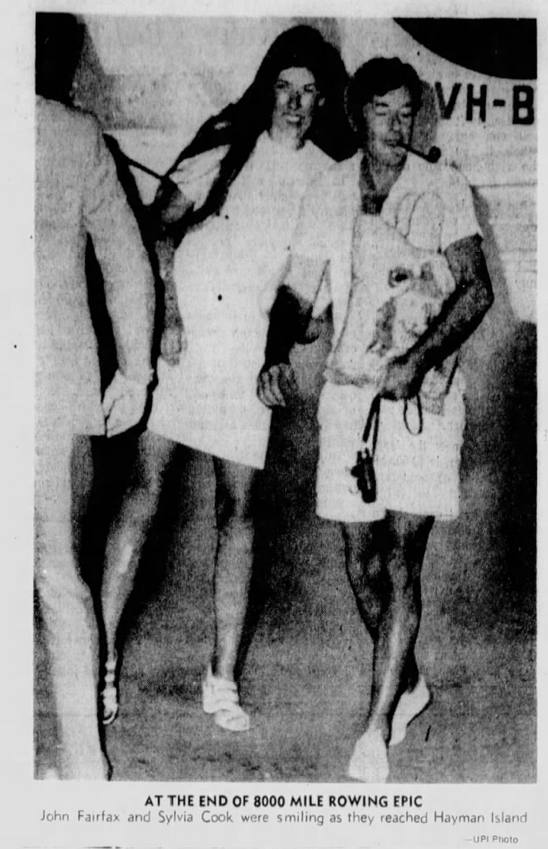
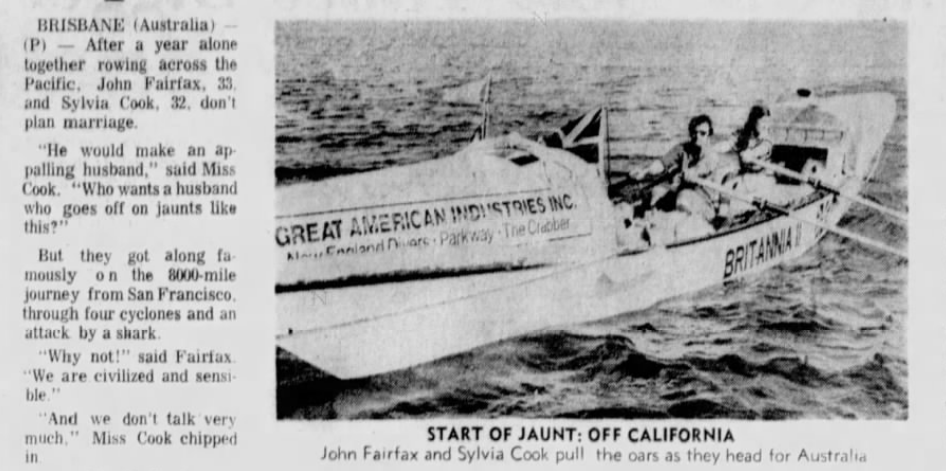
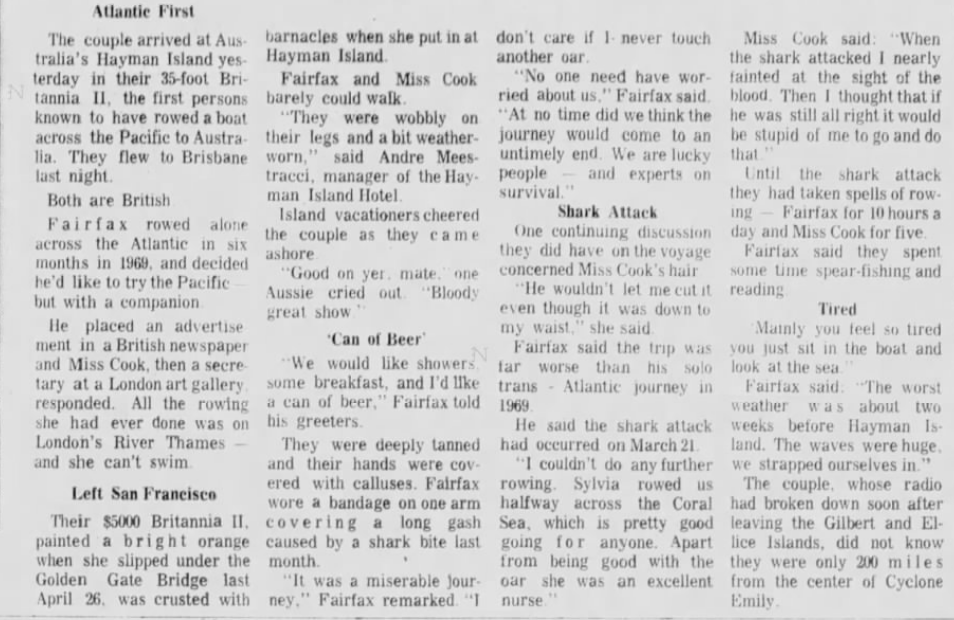
Posted By: Paul - Mon Apr 11, 2022 -
Comments (0)
Category: Eccentrics, Oceans and Maritime Pursuits, Marriage, 1970s

| Who We Are |
|---|
| Alex Boese Alex is the creator and curator of the Museum of Hoaxes. He's also the author of various weird, non-fiction, science-themed books such as Elephants on Acid and Psychedelic Apes. Paul Di Filippo Paul has been paid to put weird ideas into fictional form for over thirty years, in his career as a noted science fiction writer. He has recently begun blogging on many curious topics with three fellow writers at The Inferior 4+1. Contact Us |




